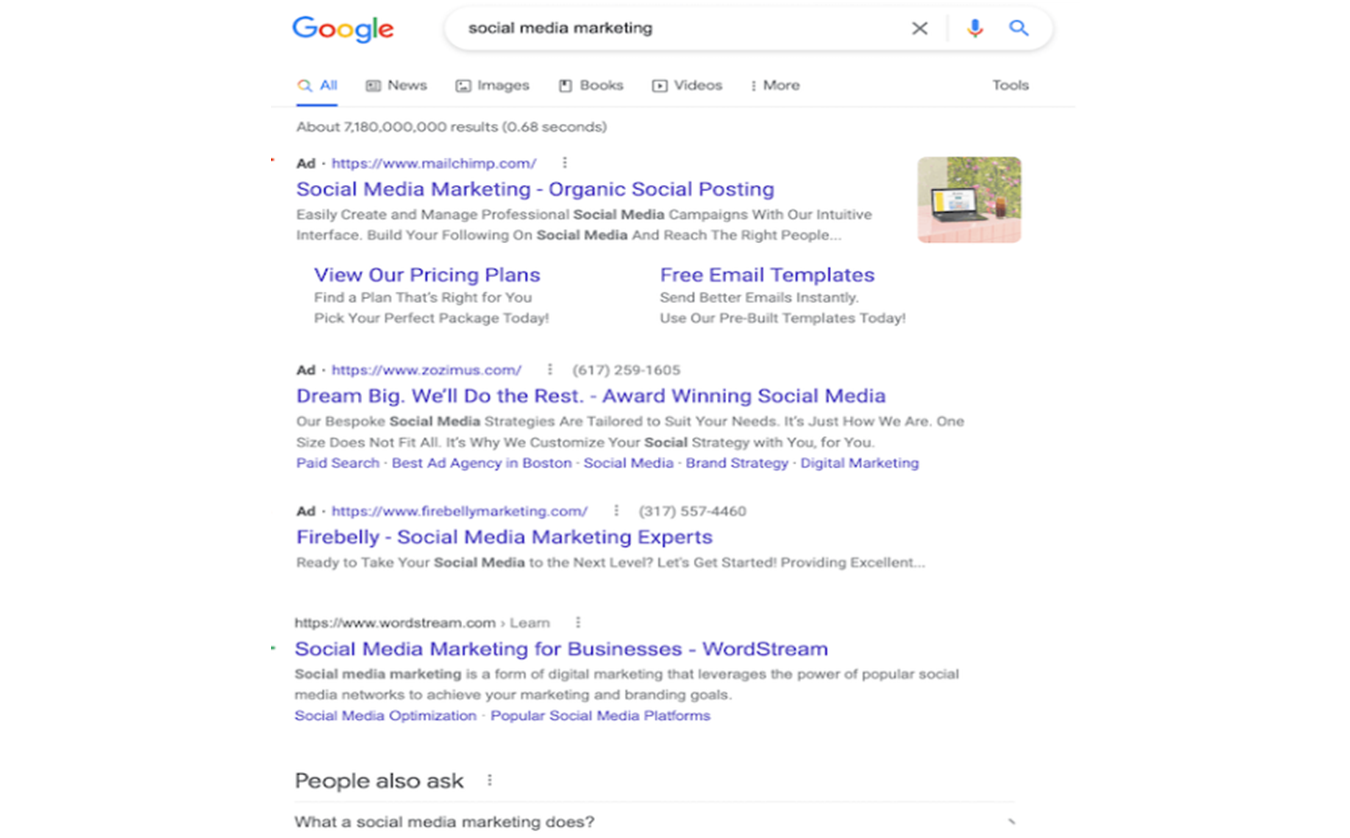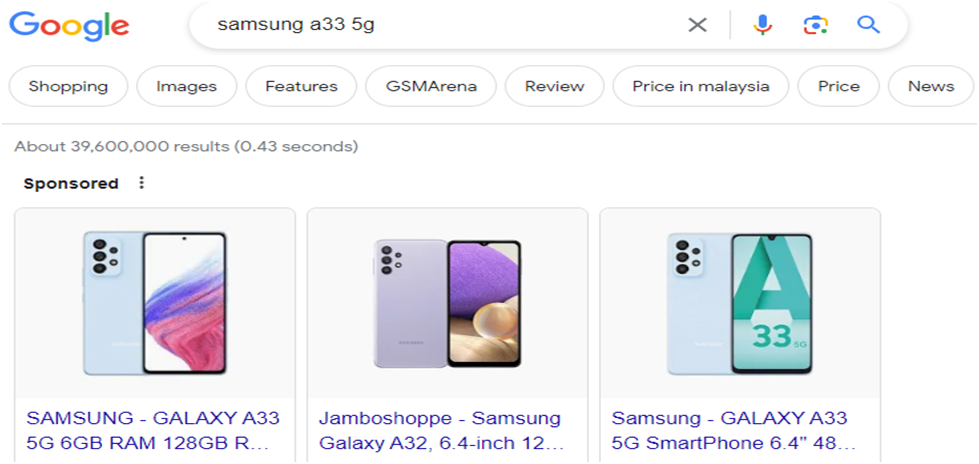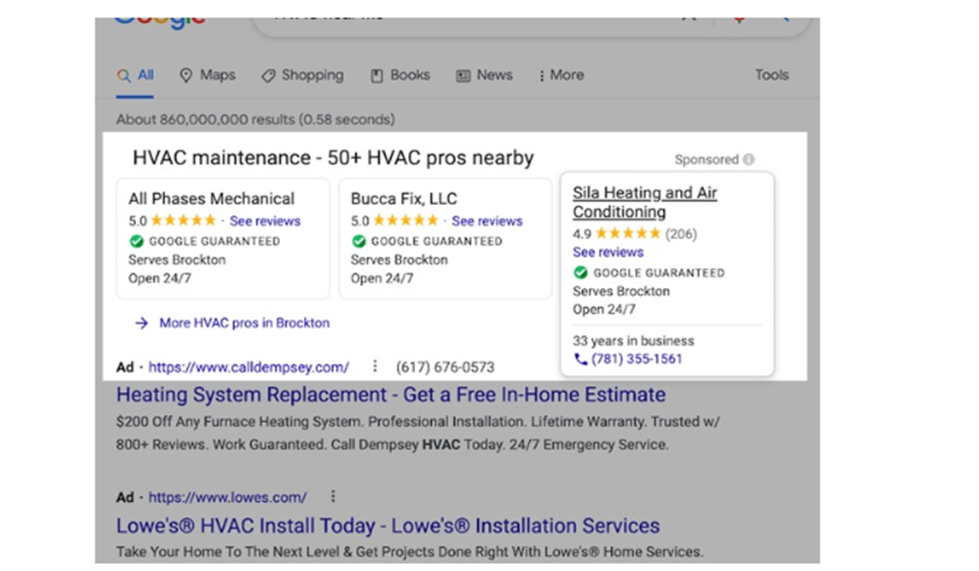All Posts / Is Google Ads worth it for small businesses?
Digital Strategy
Is Google Ads worth it for small businesses?

We cannot deny that we have all interacted with an ad in one way or another.
When you search anything on Google, the first result you are likely to see is an ad. Chances are that you are always tempted to click on the ad before anything else.
What are Google ads?
It is the other name for Google’s pay-per-click (PPC) advertising. It is Google’s online advertising platform that allows you to develop web ads that target consumers interested in the products and services you provide.
Google Ads is a truly unique marketing tool. It is used by millions of businesses worldwide to promote and create billions of dollars annually.
Google Ads allow small companies to advertise their service or products to internet users around the world who use Google to look up items relevant to their industry. It is the only tool that gives small businesses the chance to compete with veteran businesses at the global level.
No matter what industry you’re in, you can target and reach an audience motivated to buy from you daily based on understanding consumer search query patterns.
In this piece, we will walk you through a top-level overview of how Google Ads will function for your small business now and for years to come.
Cracking the Code: Unraveling How Google Ads Work
In all of the billions of Google searches that happen every second, most of the results are usually ads. They are mostly preceded by the label “ad” You have probably seen something like:

Types of Google Ads
There are various types of Google ads that as a business, you can be able to choose that which works best for your business. They include:
1. The Search ad
This is the displaying of ads on web pages that display search engine query results. On websites with other published material, advertisements can also be put using the same search-engine advertising services.
Here is an illustration of a Google SERP with advertisements:

2. Display ads
With Google ads, you can also launch display campaigns that appear on the Google Display Network. There is a sizable number of external, third-party websites here that have consented to show Google advertisements.
Your targeted advertising for Google Display can be done in various ways, such as through audiences and retargeting, and they can be in text, picture, video, or rich media format.
Here’s an example:

3. The shopping ads
These usually appear when you search for a real item that is available in any online store.
Both the main SERP and the shopping tab display Google shopping advertising. However, since you can’t target specific terms with this advertising, they work differently than ordinary search ads.
Instead, you keep a thorough inventory of your goods, and Google will match them to queries. However, you can inform Google of the keywords for which you do not want your advertisements to display. See below:

4. The YouTube ads
Since YouTube is owned by Google, all advertising on the platform uses Google Ads.
Among other advertising platforms available, it is only on YouTube that you can design advertisements that play before and during videos and everywhere on the platform. Whether they be text, video, or display. Targeting for YouTube ads functions similarly to targeting for displays. They appear as shown below:

5. Performance Max Ads
Performance Max combines all of your assets in one sweep for goal-based advertising across the entire Google network. This means your advertising might appear on the SERP, in Google Maps, and throughout the Google Display Network, YouTube, Gmail, and Discovery networks.

You provide Google with a primary aim, as well as assets and information about your products or services, so that the platform may generate advertising for you across all accessible places. You’re allowing Google to utilize machine learning to find the optimum asset combinations and placements.
6. App Campaigns
App campaigns serve the purpose of boosting app downloads or interactions, and they can be visible across various platforms including Search, Google Play, YouTube, Google Search’s Discover feature, and the Google Display Network.
These campaigns share a resemblance with other types of campaigns, showcasing concise lines of text accompanied by an app image tailored to the specific placement.

The advertisements are generated utilizing the text and images furnished within your app store listing. Meanwhile, you retain the authority to configure additional campaign preferences such as budget and geographic targeting. Google employs the information and preferences you furnish to adeptly determine the optimal instances for displaying your app advertisement.
7. Discovery
Discovery represents an additional automated campaign category within Google Ads, empowering advertisers to exhibit ads across the spectrum of Google’s feed placements, thereby enhancing the exposure of their products and services.

These feed placements encompass various spaces such as Gmail, comprising the Promotions and Social tab feeds, YouTube, encompassing the Home feed and Watch Next feed, as well as the Google app, encompassing the Discover feed. Analogous to other campaigns orchestrated by Google, you maintain control over the ad elements you furnish, such as text and images. However, when it comes to overseeing the precise locations where your ads appear, the platform adeptly handles this aspect on your behalf.
8. Smart Campaigns
Upon initiating a Google Ads account, the platform will actively guide you to establish a Smart campaign like shown below:

Smart campaigns in Google are entirely automated advertisements. Managed and crafted by Google itself, these campaigns only require you to offer preliminary details during the setup phase. They effectively promote your business across a range of platforms including Google Search, Maps, and other outlets such as YouTube or affiliated websites.
9. Local Campaigns
This variant of Google Ads campaign is now being succeeded by Performance Max.
Nevertheless, if you currently possess a legacy Local campaign within your account or if it still appears as an option when initiating a new campaign, you might be curious about its essence. Allow us to elucidate: it revolves around your Google Business Profile.
By associating your Google Business Profile with your account, you can effectively endorse your physical store or service locations across diverse platforms including Google Maps, the Search Network, YouTube, Gmail, and the Google Display Network.

Much akin to certain other campaigns that span multiple placements, you’re granted limited control over the appearance and delivery of your ad.
Your involvement primarily revolves around uploading assets, setting a budget, and composing succinct lines of text. Google leverages the information you provide to aptly determine the optimal approach for showcasing your local advertisements.
10. Local Services Ads
Google Local Services Ads (LSAs) operate outside the framework of the Google Ads platform; nevertheless, they are prominently displayed on Google Search. These ads offer customers the option to either directly call your business or initiate a message conversation when clicked upon. Establishing a robust Google Business Profile and undergoing a comprehensive verification procedure are integral steps for businesses.
Following approval, your ad will feature a distinguishable green badge or check-mark, and the payment structure entails remuneration solely when a customer reaches out to you through your ad.

How come Google Ads appear on SERP?
It all comes down to the keywords.
These are the terms that users are likely to use when searching for a product. They are usually the main focus of the Google ads.
When you are preparing to run an ad, you need to construct it with a specific offer and select a list of keywords to target that are pertinent to the offer when you start a Google Ads search campaign.
Now, when a user performs a Google search, Google looks to see whether any advertisers are competing for the keywords related to that search. If so, advertisements like yours will show up on that SERP.
The Ads Auction: How Google decides which Ad to Display
You have decided to run an ad on Google, that’s great. Does this guarantee that your ad will display anytime there is a search for your targeted keywords? No! Let us show you why.
Every second there is a search on Google, and advertisers have to compete for clicks on relevant keywords. Immediately you hit enter on that search, Google enters each relevant keyword into the auction once per account.
Depending on the relevance to the query and other considerations, it will first assign each keyword a Quality Score ranging from 1 to 10. Then, it will multiply each keyword’s Quality Score by the related advertiser’s maximum bid to determine its Ad Rank score.
The ads that appear are the ones with the highest Ad Rank ratings. Here’s what it looks like:

How do you make sure your Ad Displays Every time?
Of Course, you want to scale. And if you have turned to Google ads for this, you must make sure that your Ad shows on relevant searches. Therefore, to win your best approach is to optimize your quality score and bid amount.
If your Quality Score and your bid amount are high, you have the best chance to appear in a better position. Your Quality Score is influenced by the following elements, among others:
The higher your Quality Score, in conjunction with your bid amount, the better your ad positioning. The following factors (among others) affect your Quality Score:
- The search relevance to the search entry
- Your advertisement’s suitability for the landing page
- The Google keyword’s applicability to your ad group
- Google Ads performance of historical accounts overall
- The advertisement’s and its ad group’s previous click-through rates
If your Quality is as high as it can get, then Google will reward you with a few benefits. They include:
- Cost savings: Google lowers your cost per click (CPC) if you get high-quality Scores, enhancing ROI (Return on Investment).
- Greater exposure: If your Quality Scores are high, your ads will appear more frequently and in better SERP positions. As a result, you can increase clicks and conversions without increasing your bids.
Does Google Ads Work For Small Businesses?
Indeed, generating more leads through pay-per-click (PPC) advertising is a terrific idea.
It is also true that PPC advertisements aren’t exactly affordable, especially for small business marketing. Therefore, to achieve the results you want, you have to make sure your search has a broad match and the appropriate ad extension.

There are a lot of variables outside of your control that affect how effective and profitable your campaigns are. And with all these, you are probably wondering if the result is worth all the hassle. This section will explore if Google ads are worth it for small businesses, if so, what you can do to maximize the results. Below is an elaborate list of Google Ads benefits for small businesses:
1. Helps greatly manage your budget.
The best thing about Google Ads is that you can always work on your budget. It is the most cost-effective advertising method available. As a small business, we understand that one of your goals is to save as much as possible while performing at your best. Google Ads is your best partner in scaling while saving.
Google ads allow you to pay as you go. This means that you only pay for what you use. There’s never a minimum spending requirement. You only need to decide how much money you want to spend, when, and what you want to spend it on. By itself, this structure will lower your expenses.
When you reach your expected ad spend, it’s simple to set a marketing budget cap and immediately cease spending because there are no hidden expenses.
Additionally, automation is used by Google Ads to assist you maximize your spending. Budgets for each month can be planned and changed as necessary in real-time. Google will also provide you with helpful tips.
2. Increased brand visibility
Do you want your brand to be known? Google ads are the way to go.
By 2024, global spending on ads will have surpassed $885 Billion. This is another sign that you have to keep fighting for your place at the table. The competition among small businesses is high, and the best way to stand out is by increasing your brand awareness through Google ads.
Google Ads is the quickest and simplest way to rank highly on SERPs. That’s helpful in other contexts besides traffic and sales. Additionally, it aids in exposing your brand, personality, and distinctive company offer to a wider range of users.
3. More visitors, sales, and leads are generated with Google Ads.
Google is like a pond full of fish. It dominates over 90% of the search engine marketplace. So imagine the number you can grab from Google’s endless market.
You need to utilize Google Ads to capitalize on that sizable market share and connect with a lot more prospective buyers.
In this fast-changing digital world, if you can command a large online market share, your fate from there is upward only. Yes, your current search engine optimization (SEO) marketing or digital marketing plan can be greatly improved by incorporating high-quality paid ads. This will inevitably result in a rise in traffic, conversions, and leads. Along with increasing in-person sales, you can improve online sales.
4. Target customers more effectively
In business, especially when you are just starting, identifying and targeting a specific audience may be daunting. Lucky for you, Google ads can save you the hassle.
With Google Ads, you can systematically identify the ideal clients and display the most pertinent, powerful ads to them. Additionally, based on a variety of customization choices, you can choose the most effective keywords and target leads through:
-
-
- The type of the user’s device
- Tailored keywords
- User’s Age
- The User’s language
- The time of day of search
- The frequency of search
- The user’s location
-
These targeted adjustments raise the likelihood that the leads you receive will be of good quality. This increases conversions and improves the success of your overall digital marketing strategy.
5. The chance to customize your approach
Imagine searching for something on Google, then getting the exact thing you were looking for tailored to your needs. Cool right?
As a small business, your customer needs to have this very experience. You need to customize your solutions to solve their specific problems. Google ads help you target your customers with personalized solutions. With Google ads:
-
-
- You can quickly tailor campaigns with Google Ads to meet your company’s needs.
- Your marketing activities can be scaled up or down.
- You can choose the online advertising that will best help you reach your target audience when creating your personalized mix.
- You could even collaborate with a Google Ads specialist.
- Your campaign planning and execution are assisted by these advisors. Additionally, they frequently provide advice and one-on-one discussions.
-
The options for customization are genuinely limitless. And the sooner you realize that no two consumers are alike, you will agree that customization is essential.
Even though Google Ads isn’t the only PPC ad strategy available, it’s by far your greatest option if you’re a small business looking to boost your sales and build your brand while minimizing costs.
Best practices when using Google ads
Using Google Ads effectively requires a combination of strategy, optimization, and adherence to best practices. Here are some key best practices to follow when using Google Ads:
-
- Clearly Define Your Goals: As it is with everything in your business, have a clear goal in mind and be well drawn out. Understand what you want to achieve with your Google Ads campaign. Whether it’s increasing website traffic, generating leads, or driving sales, clearly defining your goals will help you measure success and focus your efforts.
-
- Keyword Research: While running a Google ad, keyword research should be your hobby. This is because you need to conduct thorough keyword research to identify relevant keywords and phrases that potential customers are using to search for your products or services. You can use tools like Google Keyword Planner to find high-volume and low-competition keywords.
-
- Create Relevant Ad Copy: If your Ad copy does not hit the right spot, your Ad may just go to waste. Ensure you write compelling ad copy that is relevant to your target keywords and aligns with your landing page content. Do not forget to highlight unique selling points and use strong calls-to-action (CTAs) to encourage clicks.
-
- Landing Page Optimization: Your landing page is like your resume. You need to ensure that your landing pages are optimized for the keywords and ads they are linked to. The landing page should provide a seamless user experience, be mobile-friendly, and have clear conversion paths.
-
- Ad Extensions: Never leave room for questions. You need to utilize ad extensions to enhance your ads and provide additional information to users. Extensions like site links, call extensions, and location extensions can improve ad visibility and performance.
-
- A/B Testing: Trust but verify. This means that an ad that worked last year may not necessarily work out this year. You need to continuously test different ad variations, including headlines, descriptions, and CTAs, to identify which elements drive the best results. A/B testing helps optimize your ads over time.
-
- Quality Score Improvement: Constant work on your quality score to stay relevant. Google uses Quality Score to measure the relevance and quality of your ads and landing pages. A higher Quality Score can lead to lower costs and better ad placements. Focus on improving your Quality Score by optimizing keywords, ad copy, and landing pages.
-
- Budget Management: Maintaining a static budget throughout may be more costly for you than it is economical. Here’s why. You need to set a realistic budget for your campaigns and regularly monitor spending. Allocate more budget to well-performing campaigns and consider adjusting bids based on performance.
-
- Targeting Options: Use targeting options such as location, demographics, interests, and device types to reach your desired audience effectively. Refine your targeting to ensure your ads are shown to the right people.
- Conversion Tracking: You need some way of measuring your Google Ads success rate other than Google Ads analytics. For this, you could implement conversion tracking to measure the effectiveness of your ads and identify which campaigns are driving the most valuable actions (e.g., purchases, sign-ups, form submissions).
Avoid These Common Google Ads Mistakes
You have probably been running Google Ads for a while but still not getting the desired results. You probably started to think that you made the wrong call by choosing Google ads. The truth is, if you start running a Google ad without paying attention to the very last detail, you will find yourself in a pitfall that will rather cost you than help you.
The Google Ads platform gives you a lot of options for tailoring your marketing campaigns to appeal to clients. For many people, having this many options is the only way to guarantee that every campaign is concentrated on the appropriate goal. However, this level of specificity can be overpowering, which can result in errors or subpar tactics.
Below is a list of the most typical errors you can encounter in Google Ads:
1. Using the wrong conversion actions
By employing pixels to track user activity on our sites, conversion tracking enables you to gauge those desired results.
Conversion actions ought to be viewed as those higher-value actions people can perform, such as completing a form or making a purchase.
Driving traffic to your website may be a goal of yours, but that doesn’t mean that every visitor should become a customer. These are easily measurable using already-in-use metrics like Google Ads clicks or Google Analytics pageviews.
Additionally, you do not have to accomplish all your business goals with one ad. For starters, just choose a few that are of priority so that your ads can be optimized for the right action.
2. Failing to add negative keywords
These negative words separate the sheep from the goats. What do we mean?
You obviously don’t want your business to match searches that are irrelevant to your business. You can easily help Google exclude you from irrelevant searches by adding a negative word.
For instance, you are running a digital marketing agency but you do not offer content writing. In this case, “content” can be your negative word, so if anyone searches a digital marketing agency for content writing services, your business won’t show.
Start by adding the more obvious negative keywords, then evaluate your search terms in your AdWords account by clicking on Keywords, then Search terms in the left-hand menu.
3. The use broad match keywords only
Exact, phrase and broad keyword match types are all accessible in Google Ads.
Broad is, well, the widest of the match types, despite the names not being as tightly associated with their precise uses as they once were.
In other words, it will allow your adverts to appear for a wider variety of queries than either precise or phrase, making them more likely to be clicked by users.
While there are undoubtedly situations where broad match keywords might be beneficial, they work best in a select few situations.
You should use broad match if:
- Although your account is producing good results, scaling with exact and phrase searches is proving to be difficult.
- You have a good conversion rate and can use Smart Bidding’s broad match feature.
- You’re concentrating on a group of well-known users while using Remarketing Lists for Search Ads (RLSA).
4. Using the wrong goals when using Smart Bidding
Do you see the issue with using Smart Bidding tactics that are centered on “conversions,”? This often serves to further exacerbate the issue of counting page views as conversions in Google Ads.
However, when you combine automatic bidding centered on conversions with an account that is inadvertently using pageviews as that conversion, you’re left with an account that will be fairly effective at driving consumers to click on your advertisements (costing you money) and visit your site, but not much else.
However, there are some restrictions on automated bidding and conversion optimization.
As someone who has been in this profession for more than ten years, I’m still wary of handing over the keys to the kingdom, despite Google’s promises that their system is intelligent enough to recognize what conversions you want and optimize for them without much input.
Conclusion
A successful small business relies on comprehensive advertising strategies. This, you can fulfill by using Google Ads.
Using Google Ads for small businesses has several advantages. It has special characteristics that rivals lack and can do a lot for your company.
Are you looking to increase lead generation, sales, and brand exposure quickly?
Try out the marketing options from Telco ICT. Along with complete marketing and design support, we provide automatic Google Ads solutions. We also add beneficial SEO, social networking, and PPC features to grow your business.
Along with marketing services, we also offer dedicated hosting, shared hosting, and VPS hosting if you’re seeking for hosting options.
Talk to an expert today to start expanding your consumer base, creating your brand identity, and enhancing the functionality of your website right away.
Frequently Asked Questions:
1. Is Google Ads suitable for my small business budget?
Answer: Yes! Google Ads can be tailored to various budgets, including small businesses. You can set daily or monthly budget limits to control spending. Start with a conservative budget and gradually increase it as you see positive results and ROI.
2. How can Google Ads benefit my small business over other advertising methods?
Answer: Google Ads allows small businesses to target specific audiences based on keywords, location, interests, and demographics. This precise targeting can lead to higher conversions and a better return on investment compared to traditional advertising methods.
3. Will my small business gain enough visibility among larger competitors on Google Ads?
Answer: Yes! While larger competitors may have larger budgets, Google Ads uses a combination of bid and Quality Scores to determine ad positions. If you optimize your campaigns effectively, you can still achieve good visibility and attract relevant clicks.
4. What are the potential risks and challenges of using Google Ads for small businesses?
Answer: Some potential risks include overspending without adequate ROI, improper keyword targeting, or ineffective ad copy. To mitigate these risks, it’s essential to have a clear strategy, conduct thorough research, and regularly monitor and optimize your campaigns.
5. How can I measure the success of my Google Ads campaigns for my small business?
Answer: Google Ads provides various performance metrics, such as clicks, impressions, click-through rate (CTR), conversions, and cost-per-conversion. By tracking these metrics, you can assess the effectiveness of your campaigns and make data-driven decisions to improve results.
Table of contents
Related Posts
We’ll handle the tech
so you can get on with
running your business.

CALL US
1300 414 214
Our Trusted Partners
Contact Us
Let’s Talk
Common Questions
Do you outsource your work overseas?
No. We use local teams only. That way we can respond more quickly to any problems that may occur. We want your tech running smoothly so you can focus on what you do best.
Is your support 24 hours?
Yes. We have people available whenever you need us. We understand that your tech runs 24 hours, and you need it be working at all times.
Are your services customised for my business?
Yes. There is great off the shelf software. But we know one size never fits all. So anything we set up for you is designed to make your business run smoother and in the way you want it to.
Are your services expensive?
No. Reliable tech is the life blood of your business. We keep it running smoothly so your business can keep making money. All our services are fixed fees, so you never get any nasty surprises.
What’s the next step?
Simply book a chat with one of our experts. We’ll have a chat about exactly what you need and how we can help. If you like our approach then we’ll give you a fixed price quote and get everything up and running for you, fast!








